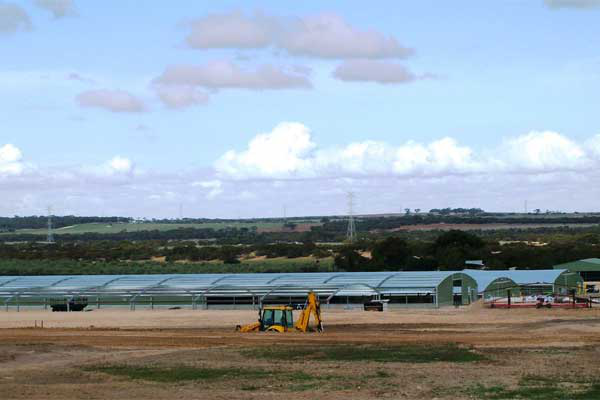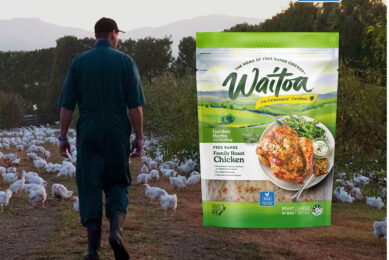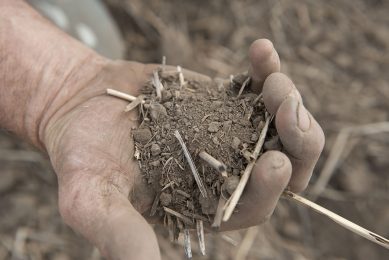Spanlift revolutionises poultry buildings

A broiler house is a broiler house – a building to keep chickens inside consisting of four walls and a roof with ventilation openings in the walls and feed and water equipment inside. Sounds simple and it is simple. Still there are many ways to fill in this broad sketch. Spanlift Broiler Buildings in Australia specialises in a specific way of constructing these houses, and with success and brilliant bird results.
By Dick Ziggers
Nine o’clock sharp Shaun Williamson enters the hotel in Adelaide to pick me up to go to Jordan Poultry – a good hour drive eastwards past the town of Murray Bridge just off Kepa Road. Williamson is a 22 year old bloke (as they would say in Australia) who runs a roofing and construction company with his business partner Brendan Roberts. “I’m already in this business more than fi ve years,” Williamson says. “I didn’t think much of school and wanted to work and earn money. I’ve learned the hard way too, but now things are running more smoothly.” He also tells me that he has around 15 people under his employment, which is quite a challenge for such a young guy. The project Williamson and Roberts are working on is a newly planned 20 shed broiler facility, which was submitted by Jordan Poultry, who is going to grow broilers for Inghams, Australia’s largest poultry integrator. Williamson drives his pickup truck at the turn off of Kepa Road on to a dirt track. The sign is there: Jordan Lane. After passing some shrubs a wide open space in a somewhat sloping landscape appears. Shovels are digging dirt and a few brand new green poultry sheds gleam in the early winter sun. The open fi elds are a perfect area for keeping poultry, which contributes to easier climate control. The whole unit is split in two sections each of 10 sheds to be situated at a fair distance from each other, for biosecurity and management reasons. The whole farm is developed to be extremely low maintenance and can be run by one person. Each farm of 10 sheds also will contain a machinery shed, a site offi ce, water tanks, 15 feed silos and a stormwater detention basin. Each shed is 153 metres long by 15.3 metres wide and can hold up to 43,500 chickens, totalling 435,000 broilers per farm at any one time. Williamson, not without pride, starts showing me around. The project is in its fi rst construction phase; the land has been levelled and construction is well under way; the fi rst batch of broiler chicks have been put in the first two sheds and is already ten days old at the moment of visiting.
Curved ceiling
Nothing extraordinary so far. The difference is however the way the sheds are constructed and the materials that the buildings are made from. Jordan Poultry commissioned the construction of the sheds to Spanlift Buildings, located at Mount Gambier, some 350 km southeast of this premises and close to the border of the state of Victoria. Soon after I arrive Jon Cox and Drew Pudney from Spanlift also steer their pickup truck on the dirt between the sheds. Cox is responsible for Intensive Farming Solutions at Spanlift and Pudney is operations manager. Cox explains that Spanlift is a family business existing since 1975. Their former trading name Action Structural was changed in late 2007 to Spanlift Buildings. The name refl ects the unique construction method they specialised in of lifting the roof of a building that is preassembled on the ground. The company specialises in fabrication of many types of quality steel buildings. “All of our buildings are manufactured from heavy structural steel that is then fully hot dip galvanised,” Cox says.
There are many diff erent ways that sheds can be built. Some companies off er turnkey contracts. As Spanlift are specialists in shed construction they don’t get sidetracked by the fit-out procedure of feeders and drinkers and leave this up to the growers preferred equipment supplier and the equipment supplier’s expertise in fit-out. “Spanlift’s designs are easily accommodated to accept all types of feeders, drinkers and ventilation equipment, and their ‘modular’ design make this easy for the fit-out teams, this results in the best quality job at a fair price,” Cox explains. That is why Williamson was selected to build the sheds for Jordan Lane Poultry.
Spanlift has revolutionised poultry housing. The poultry house design team came up with a unique curved ceiling that provides superior ventilation, which is coupled with an ammonia resistant clean skin lining. “Next to the hot dip galvanising of the steel work, the paired surfaces are fully sealed and the roof iron comes with a 25 year warranty,” Cox says. Cox went to the UK for research on new developments in poultry house construction and from there the concept ripened from a regular straight forward shed to a construction with metal sheet polystyrene sandwich panel walls and rounded trusses in the roof with galvanised roof purlins. The roof is further insulated with a 75mm fibre glass blanket. The sandwich wall panels are green on the outside – here to blend in with the environment, but these could have any colour. The inside is white for better refl ection of temperature and light. The whole shed is pre-manufactured at the factory and assembled on location.
The concrete lower side rodent proof walls with a height of app. 50cm are also pre-fabricated and transported to the building site in one piece. “We have developed these side wall foundations from a specific type of concrete, which is a mix of concrete mortar with an insulation product that forms a stable concrete beam that is strong, lighter than concrete alone and has excellent insulating properties,” Cox explains, not willing to further elaborate on the exact ingredient of the concrete mix, due to the companies intellectual design.
Since the revolutionised design was released in 2009, Spanlift has constructed over 50 poultry buildings with another 30 expected to be completed by mid- 2013. The management of the company recently went to the UK Pig & Poultry Fair in Stoneleigh to investigate if there would be export opportunities into Europe for their concept.
Climate control
The climate control inside the buildings is fully automated and consists of a combination of side inlets with tunnel ventilation. The air inlets are situated high in the side walls. Due to a 0.75 bar negative pressure the incoming ‘cold’ air through the side inlets moves along the curved ceiling towards the centre of the shed where it mixes with the hot air to finally descend to the birds. To assure a free fl ow of air, the light fi ttings on the ceiling have been turned to a 90° angle of the walls to avoid air collision. At the rear of the building 13 giant 54 inch (1.37 m) fans can refresh the air quickly when needed and extra pad cooling units in the front side walls can further cool the incoming air when necessary. Maximum airspeed is set at 3 m/s. The whole system is controlled by a Rotem computer.
Today is a relatively cold day with an outside temperature of 18°C with quite a bit of wind. Farm manager Simon Whitaker takes me inside the shed and shows how the indoor environment is with the 10- day old birds. When observing the broilers it is remarkable to see how even they are spread through the house. Due to the intense computer climate controlling, every now and then one fan jumps on to extract some stale air. Whitaker is pleased with the finishing of the house. He’s been a farm manager in a few other places, but fi nds these new houses top notch. “The attention to detail is important,” he says. The shed is equipped with Cumberland feeding pans and nipple drinkers, all mounted on the ceiling, which is fitted with hooks and eyes for easy hanging of the steel cables to lift the feed and water equipment. The broilers are kept on a 12 hr light – 12 hr dark regime, with the light period being from 4am to 4pm. During that light period they are kept at 5 lux, which is still relatively dark. Whitaker estimates the cost of a fully equipped shed to be A$650,000 (app. €535,000). “You need to optimise everything to be able to achieve high production rates. These sheds might be a bit more expensive, but it is return on investment that a farmer should look at. Especially after five years when the maintenance costs run in.” Although this is the fi rst batch in the house, Whitaker has a good feeling about it, especially since mortality is only 0.72% in these first 10 days. Also the litter is perfectly dry, considering it is the first batch and the birds are kept on a dirt fl oor.
Whitaker finds the new houses pleasant to work in. When we go outside again he even expresses some philosophical thoughts about that. “I think I will give every house the name of a lady. This fi rst one is going to be called Nora, after Nora Jordan, who is buried on this estate,” he says and then disappears in the house again to do some controls.
For me it is time to go and this time I jump into the pickup truck of Cox and Pudney and we drive to the highest point of the estate, not only for a nice view on the developments, but also because here the stormwater basin is situated for collecting run-off water from the roofs, a requirement set by the planning commission. Then it is downhill again and back to Adelaide in admiration of the expansion drive of Jordan Poultry.
At the time of print it was reported that the birds had reached and exceeded the required weight three days before the scheduled harvest date. There is no doubt in the owner’s delight at the return on funds of his investment.













